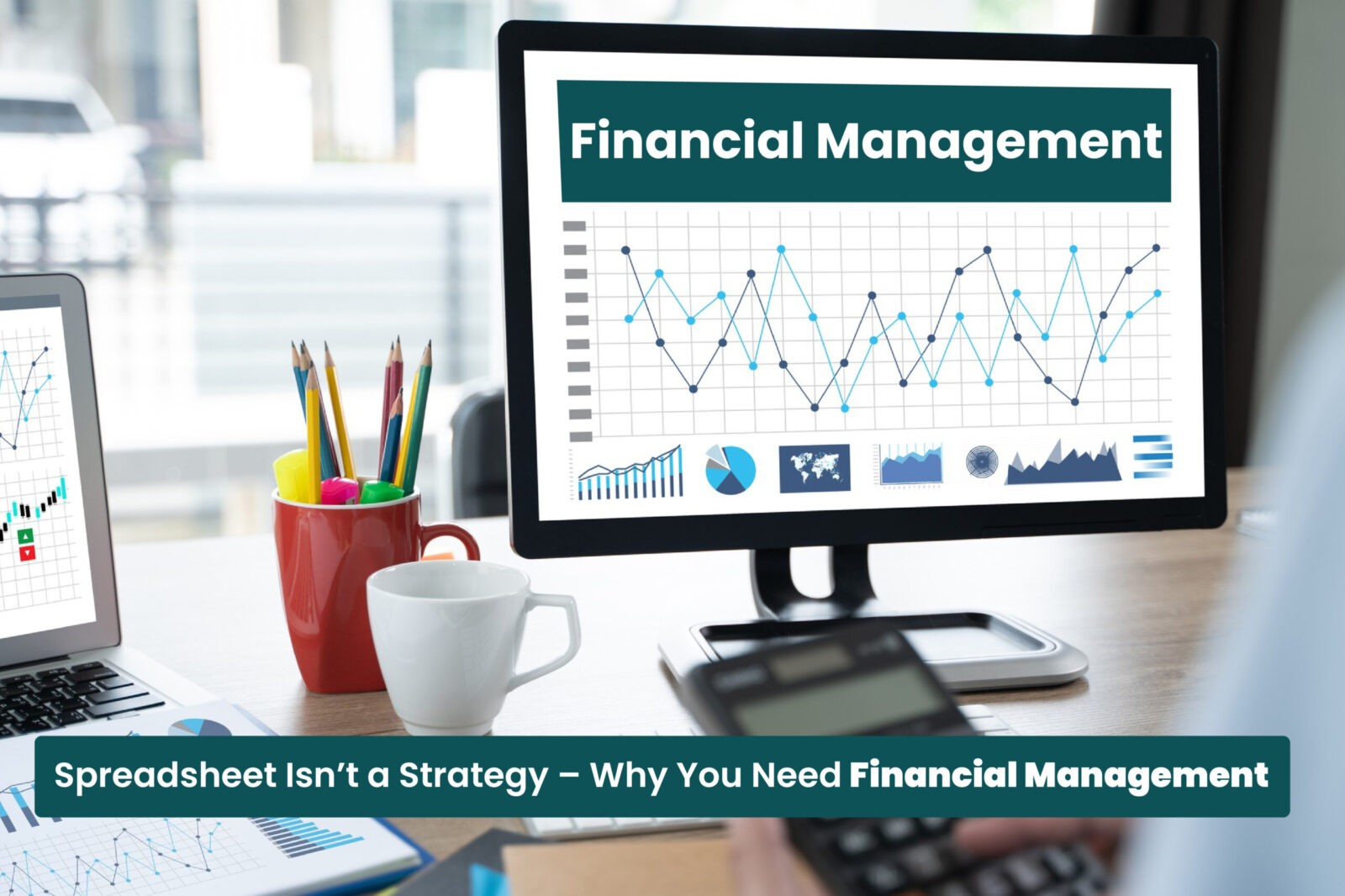Let me ask you something — have you ever spent hours updating your business spreadsheets, only to still feel unsure about where your money really stands? You’re not alone. So many business owners think that as long as they have their numbers in neat rows and columns, they’re in control. But here’s the harsh truth: a spreadsheet isn’t a strategy.
That’s right. Just plugging numbers into Excel won’t save your business from surprises or bad decisions. In fact, it can lull you into a false sense of security — until the bills come due or a sudden expense hits, and you realize your numbers don’t tell the full story.
This is why financial management is so much more than “doing the books.” It’s the difference between reacting to problems and steering your business confidently toward success. Today, I want to walk you through why relying on spreadsheets alone is one of the biggest planning mistakes you can make — and how embracing smart financial management can turn your business around.
Spreadsheet Illusion: Why It Feels Safe — But Isn’t
Spreadsheets are everywhere because they seem simple, familiar, and inexpensive. You can build your own system, customize it, and keep all your data in one place. Sounds great, right?
Studies show that nearly 9 out of 10 spreadsheets have errors. That means businesses are often making decisions based on flawed data — sometimes costing thousands or even millions.
Spreadsheets don’t update automatically. You have to remember to input every transaction and hope you don’t make a typo. They can’t give you real-time alerts when cash runs low or forecast how a new project might affect your finances.
So, while spreadsheets might give you a sense of control, they’re really just a static snapshot — not a living, breathing financial plan.
So, What Exactly is Financial Management?
Think of financial management like being the captain of a ship. It’s about more than knowing where you are on the map — it’s about plotting the best course, adjusting when the weather changes, and making sure your ship doesn’t run out of fuel.
In business terms, financial management means planning, organizing, controlling, and monitoring your money so you can meet goals, stay profitable, and grow sustainably.
Instead of just tracking numbers, you’re asking:
- How much money do I actually need to keep things running?
- Where should I invest to get the best return?
- What risks am I facing, and how do I prepare for them?
When done well, financial management becomes your secret weapon — helping you spot opportunities and avoid disasters before they happen.
Why Smart Accounting Matters More Than You Think
You might think “accounting” is just boring paperwork or tax season headaches. But smart accounting is what powers good financial management.
Imagine having your books updated automatically, with your expenses and sales connected to your bank accounts. Imagine dashboards that show you exactly where your money is, how fast it’s moving, and what your future looks like — all in real time.
Smart accounting tools do this. They reduce mistakes, save you time, and give you the insights you need to make smarter decisions.
And the best part? They connect directly to your finance strategy so everything is working together — not in silos.
What Does a Good Financial Strategy Look Like?
A financial strategy isn’t a fancy buzzword. It’s a simple plan that shows how you’ll manage your money to reach your goals.
For example:
- How much cash do you need to keep on hand to cover expenses?
- What pricing will cover costs but still attract customers?
- Should you take out a loan, or look for investors?
- Where can you cut costs without hurting quality?
Without a solid financial strategy, many businesses just “hope for the best” — and that’s a recipe for stress and mistakes.
According to the Small Business Administration, 82% of small businesses fail
because of poor cash flow management.
That often comes down to skipping real financial management and relying on guesswork.
Why It’s Time to Move Beyond Spreadsheets?
Switching from spreadsheets to a financial management system might sound intimidating. But it’s one of the smartest moves you can make.
Here’s what modern tools offer:
- Automated invoicing and payment tracking — no more lost bills or late fees
- Real-time cash flow monitoring so you always know where you stand.
- Forecasting features that let you run “what-if” scenarios.
- Integration with your sales, inventory, and payroll for one source of truth.
- You get the full picture, not just pieces on a spreadsheet.
Common Mistakes You Can Avoid with it
Let’s be honest — we all make mistakes. But some cost more than others. Here are a few planning mistakes that happen when you rely too much on spreadsheets:
- Mistake #1: Thinking you’re profitable because your sales look good — but running out of cash because customers haven’t paid yet. It helps you track cash flow separately from profits.
- Mistake #2: Overestimating how much money you’ll bring in. Smart financial planning forces you to be realistic and prepare for slow months.
- Mistake #3: Letting expenses sneak up on you. Without detailed cost tracking, you miss opportunities to save.
- Mistake #4: No backup plan for unexpected events. It lets you test different scenarios so you’re ready for surprises.
How to Get Started with Financial Management Today
You don’t have to overhaul everything overnight. Start with these simple steps:
- Look honestly at your current finances. Gather all your spreadsheets, bank statements, and invoices. See where the gaps and risks are.
- Set clear financial goals. What do you want to achieve in the next 6 months, year, or 5 years?
- Pick a financial management tool that fits your business size and needs. Many affordable, user-friendly options are available.
- Automate your accounting as much as possible. Let the system do the heavy lifting.
- Check your financial reports regularly — don’t wait until tax time.
Ask for help if you need it. A financial advisor or accountant can help you build a plan that works.
How Financial Management Saved Businesses?
I want to share a quick story about a small business owner named Sarah. She was managing her café with spreadsheets and paper receipts. One slow month, she ran out of cash and almost had to close. After switching to a simple management system, she saw where her money was leaking, adjusted her pricing, and planned for busy and slow seasons. Today, she’s profitable and stress-free.
Or take James, who runs a manufacturing business. By integrating his financial management with inventory and sales, he cut costs by 20% and increased profits. He says, “I never realized how much money I was losing until I had real-time financial insights.”
Don’t Get Left Behind
Technology is changing how businesses handle money. AI-powered tools can predict trends, spot errors instantly, and even automate tax filing. Businesses that stick to spreadsheets risk falling behind competitors who embrace smart management.
Imagine your business running smoother, your decisions backed by data, and your future less uncertain. That’s the power of this.
Your Business Deserves More Than Spreadsheets
If you’re still relying on spreadsheets to manage your finances, it’s time for a change. It is about taking control, reducing stress, and setting yourself up for success.
Remember, spreadsheets are just tools — not strategies. To truly grow and protect your business, you need a clear financial strategy backed by smart accounting and modern financial management.
Take the first step today — your business’s future depends on it.
FAQs
Q1: What is financial management, really?
It’s managing your money smartly to help your business reach its goals, avoid risks, and grow steadily.
Q2: Can I still use spreadsheets if I’m a small business?
You can, but they shouldn’t be your only tool. As you grow, spreadsheets often fall short — automating and integrating your finances is key.
Q3: How often should I check my finances?
At least monthly. More often if possible. Staying on top keeps surprises away.
Q4: What are the biggest mistakes helps me avoid?
Poor cash flow tracking, unrealistic revenue estimates, uncontrolled expenses, and no backup plans.
Q5: Where do I start with it?
Assess your current system, set goals, pick the right tools, automate, and review regularly. Don’t hesitate to get professional help.



